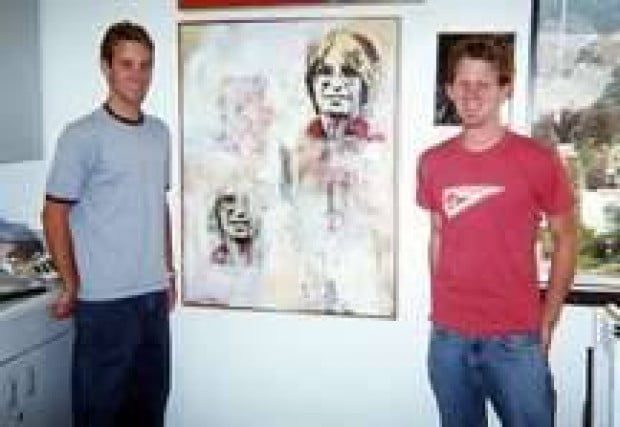With its themes of alienation, cultural excess, childhood nostalgia and reverence for the natural world, it’s clear the art muse has been working overtime in the stellar visions of 11 Pepperdine students whose works are now on exhibit in “Eleven Violations of Haz-Mat” at the Frederick R. Weisman Museum until April 27.
The varied and often provoking multimedia exhibit reflects choice works by Pepperdine’s senior art class in painting, photography, sculpture and pottery in a unified showcase highlighting the students’ keen sense of purpose and unapologetic originality.
This is the first major exhibition for Justin and Jason Herber, 21, Texas born fraternal twins who are represented in 17 of the show’s paintings. The brothers’ work is as contradictory and distinct as their personalities suggest, yet they assert, “We have the same foundational blocks, we just express ourselves differently.”
Deeply influenced by music, Justin Herber pays homage in two exhibit works to the musicians who have had an affect on his life and art. In “Sandman (Cure for Pain),” Justin offers a haunting black and white portrait of the late Mark Sandman, an almost expressionistic interpretation of the former front-man from a rock band called Morphine. Sandman, Justin laments, “died on stage.”
In a painting entitled: “Don’t Let Me Be a Painter (Because Everyone Comes to Look),” so-named from a line from a song by the band Phish, Justin’s distinctive brush-stroke technique comes to the fore in a blaze of color, bringing an energetic realism to the piece depicting Phish’s key vocalist.
“I attempt to create a portrait of the moods and energies of my generation,” said Justin, adding, “It’s a generation of boldness, freedom and desire for expression.”
Waters run deep in Jason Herber’s work. He is an artist who enjoys working with different materials and who says his paintings are characterized by the “passage of time in my own life.
“My life experiences have fueled my art ever since I stopped eating crayons,” said Jason. “The grid-like patterns throughout my work represent my own life and reflections, as minutes, hours and days that are all part of a single structure.”
Jason’s mixed media “Srpuce” (not Spruce) offers one of the most striking examples of his unique “picking” style. “My work is very topographical,” he said. “[My paintings] look like they have gone through a state of deterioration. I see them as imagined worlds or landscapes.”
As to sibling rivalry, Justin said: “There has never really been competition between us because we both excel in our own areas. There is a drive that we give each other. You learn from each other’s mistakes, you see what the other is doing. It’s like living two lives at once.”
Largely, the brothers agree that art should be “enjoyable for the artist” and say they are “both deeply involved in what each other is doing, thinking and feeling.”
The next three or four months will prove an interesting challenge for the twins as they embark on separate journeys after graduating. The two have rarely been separated from each other. Justin is going on a summer trip around the world and Jason is enrolling in an architectural program at Texas A&M.
In other intriguing works, the wistful nostalgia of Susan Fagan’s paintings, “San Simeon, A Honeymoon Evening” and “Still Meadow,” is perhaps only exceeded by the artist’s personal statement entitled: “Places in the Heart,” a collection of written memories so compelling, a writing career might be entertained.
Social angst is best illustrated in Melinda Budde’s self-portrait, and particularly in Budde’s, “The Wake,” which effectively conveys the black void of human alienation. Said the artist: “These works, painted during a time of stress and hardship in my life, reflect my feelings and concerns at that time.”
“Acknowledge the totality of your being” is a phrase from the book: “Don’t Sweat the Small Stuff,” a line sculptor Cleta Renee Fussell said was the inspiration of her body of work. The artist’s declaration is embodied in a sculpture entitled: “Rene Reborn,” in which Fussell utilizes beads and natural material in a unique form.
One of the exhibit’s most arresting pieces is found in Jennifer Peery’s reverence for the environment in a massive oil painting entitled, “Big Blue,” wherein the motion of a wave cascades in a flurry of color. “Nature is very important to me and [has] given me much peace and solace in my life,” said Peery.
Other works include Rima Rackauskas’ black and white photography, Matt Thomsons’ “Organically Grown Painted Metal Sculpture,” Annie McKenna’s sophisticated ceramics and pottery, Emilie Fitzhugh’s “Sea of Reflection,” and Usha Wilbur’s strong use of color and organic shapes, as demonstrated in a piece called “Inner Workings.”
“All of these students worked very hard,” said Avery Falkner, Pepperdine professor of art. “It’s always a luxury to have more [work] than you can use. There is an interesting variety and media represented here in a strong and professional-like show.”


